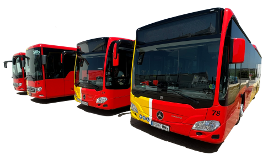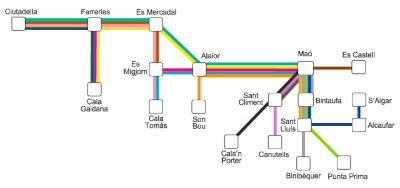

Routes and Schedules

Summary of shedules
Download abbreviated TimetableSubscription to TMSA information notices
Since the subscription page, you can register in our system of registered users and will send all our notices directly to the email address you specify.Request to travel with bicycles
Book traveling with bicyclesTMSA on Twitter
Tweets by TMSA_InfoService notices
Our history
The Compañía de Autobuses de Ciudadela (now Transportes Menorca, S.A.) started running a scheduled passenger service in 1907, two years after another company which had opened in Mahon. However, it was the company from Ciutadella which would continue alone until our times.
In January 1908 the company’s founders, who were memebrs of the nobility (including the Count of Torre Saura, who acted as director) issued partnership shares for the value of 100 pesetas each. Juan Vilafranca and Gabriel Cardona were the company’s first drivers, as well as being the first people in Minorca to take the test for a driving licence.
Joan Vilafranca Barceló reminds us that the first bus company in Minorca started at the turn of the century and was based in Mahon. However, like all beginnings, the company’s first steps were difficult and its development was plagued with set-backs and problems.
In 1907, a number of members of the nobility of Ciutadella (amongst them the Count of Torresaura, the Baron of Lluriac, Pedro Salort Martorell, Joan Simó Olivar and others) decided to found a new company which was to be called Compañía de automóviles de Ciudadela, with the Count of Torre Saura acting as its director while Salort Martorell held the position of manager. In order to finance the new company, its backers issued bonds in 1908 worth to the value of 50,000 pesetas which were divided into partnership shares of 100 pesetas.
On the shares it stated (under the heading “Compañía de Automóviles Ciudadela”) that the bearer was participating in “the operation of the automobile service on the island of Minorca, in accordance with the conditions recorded in the articles of association of said company”. They were signed by the director of the company, the Count of Torresaura, and were dated 1 January 1908.
Scheduled Passenger Service
The Ciutadella-based company, whose history began in 1907, was founded with the aim of establishing a scheduled passenger service between Ciutadella and Mahon. It was the second transport company to be founded in the island, after the one founded in Mahon in 1905. One interesting fact is that the first coaches used by the company from Mahon were steam powered and coal fired, and had solid wheels. The coaches, which reached Mahon in 1905, were built in France by the Dion Bouton company and arrived at the port disassembled. They arrived on 9 September, but as they still had to be assembled on the island, they could not start work until 3 March 1906. These coaches held few passengers (they had 18, 20 and 24 seats) but it is worth noting that they were the first to be registered in the Balearics, and had the registration numbers 8, 9 and 10.
The astonishment these vehicles generated amongst the pedestrians who saw them driving around (even though their speed never exceeded 30 kilometres per hour) was such that the people of Minorca soon named them "the fiery beasts".
Autobuses de Ciudadela
As for the bus company founded in Ciutadella in 1907, it is worth mentioning at first that, unlike what was said about the one from Mahon above (whose first buses ran on coal), the first passenger coaches in Ciutadella (two 24 horsepower Delahaye with 10 and 19 seats) had petrol-powered engines.
At first, the company’s coaches were driven by a Frenchman, who soon taught this novel occupation to two Minorcans: Joan Vilafranca Saltó (who was of Catalan roots, but was resident in Ciutadella) and Gabriel Cardona Carreras. They were the company’s first official drivers, until, between 1918 and 1919, they took over the older company.
The new company was given the name Automóviles Menorca, and later went by the name of Vilafranca y Cardona, S.L. until 1951 when it merged with Roselló y Compañía. This is how the company came to be called Transportes Menorca, S.A. in 1961, the name it still goes by today.
A Historic Driving Test
As we saw above, Joan Vilafranca and Gabriel Cardona were the first drivers on the Ciutadella-Mahon route. Joan Vilafranca’s career started as a ship’s engineer and as such he sailed on the Bilbao-Liverpool route with the ship “El Turia”. Vilafranca was a Catalan (originally from the town of Vilaseca) who came to live on the island when he married a Minorcan woman called Ángela Pons. At first, the couple lived off a small workshop that they set up in the city.
For his part, Gabriel Cardona was from Mahon and married Anita Sampol de Palós in Ciutadella. He was a blacksmith by trade, although he had previously worked as a mechanic in the Military Engineers of Mahon.
However, Vilafranca and Cardona’s lives were to change radically (at least professionally speaking) in 1908, specifically on 20 May of that year, when the engineer Miguel Massanet y Beltrán came to Minorca. His mission was to test Joan Vilafranca and Gabriel Cardona for their drivers licences. Massanet was satisfied with their abilities and he passed them, stating that both candidates had shown that they were capable of driving any car.
This was a historic test, as it was the first driving test to be held on the island of Minorca.
The first coaches
Moving on in time and in the history of the Ciutadella passenger company, it is worth mentioning the first coaches to cover the scheduled route between Ciutadella and Mahon. The pioneers in this task were the Hispano-Suizas which operated between 1928 and 1929. These coaches had 30 and 40 horsepower motors and a capacity of 32, 28 and 22 seats respectively.
The Hispano-Suizas were later followed by General Motors Studebaker coaches. The company had two of these, which arrived in 1934 and 1935. These had a capacity of 28 and 32 seats, respectively, and had hydraulic brakes. They carried on in use after the Spanish Civil War, although the shortage of petrol made it necessary to install wood gas generators, which ran on charcoal made from holm oak and pine.
Another type of coach used was the American Chevrolet Master with 35 seats, a lorry cab and body-work made in Alaior. These were the same as the ones used by the army at that time. Their approximate price was 35,000 pesetas: a fortune at that time. Juan Vilafranca still recalls their registration numbers: PM 7711 and PM 7772. There were also British-made Bedford coaches which were petrol-powered, and which later had 6-cylinder Perkins motors installed. Their registration numbers were PM 7566 and PM 7562. The bodies of these coaches (which were made of wood) were made in Arbucias, Girona by the Ayats factory. Vilafranca says there was also a manufacturer of this type of bodywork in Minorca in Alaior (Gabriel the coach-builder), although the ones made in Girona turned out to have better suspension.
Later on the Pegaso coaches arrived, with body-work made in Zaragoza by the Escoriaza y Fabro company, although their chassis were made in Barcelona in the former Hispano Suiza factory. Despite being far from the best coaches, this type of was purchased because of the protectionist policies followed by Franco’s government, which favoured Spanish companies and in the face of a currency shortage prevented the purchase of vehicles from overseas.
So many memories
Juan Vilafranca Barceló (the grandson of Juan Vilafranca Saltó) followed his grandfather’s footsteps into the world of driving and coaches, and, like his father (Juan Vilafranca Pons) and his uncles Adolfo and Ángel, he was also to work as a driver with Automóviles Menorca.
This is a far-cry from the present day, when all of Transportes Menorca’s buses (built by Pegaso, Iveco and Daf) have air conditioning and the highest standards of comfort. The fleet, consisting of some 20 units, guarantees the comfort and safety of our passengers. In the whole history of the company (over 90 years) there is no record of any fatal accident. Juan Vilafranca concludes by saying that, far from a desire for wealth, what has always characterized the company has been a spirit of service to society.
We would like to thank Luis Negro Marco for his help in compiling this information.
Routes and Schedules


